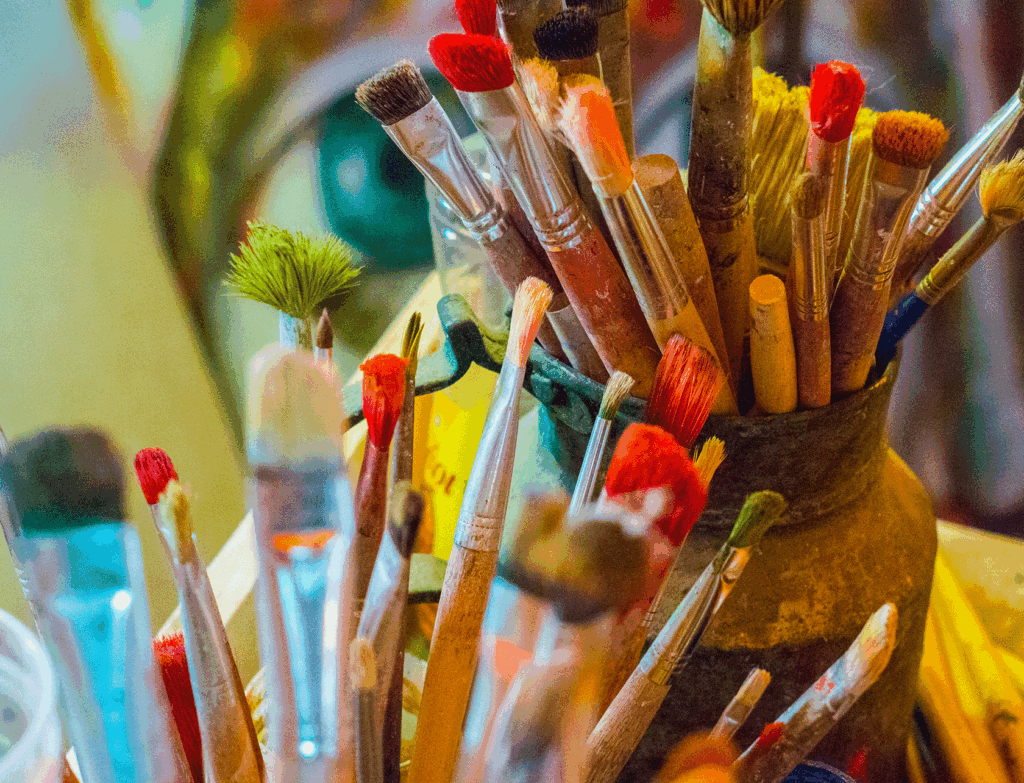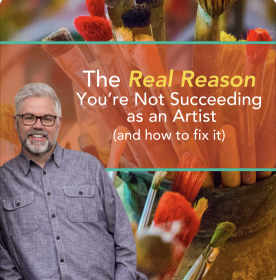Have you ever struggled with where to advertise yourself as an artist? There are so many options out there for you to consider that it can be overwhelming, not to mention expensive.
I’m going to dissect that today and dive deep into how to get the most out of your advertising dollars here in this episode of 5 Minute Mentoring.
Take a few minutes to listen on your app of choice like ApplePodcasts, Stitcher, Spotify, GooglePlay or online at http://www.MattTommeyMentoring.com/podcast
Ok, enjoy the podcast!
Matt
PS – Did you review the podcast yet? Screenshot the review, post the screenshot to your Instagram feed, and tag @thethrivingchristianartist. Do that, and I’ve got a surprise for you if you do…. #justsayin
Connect with Matt online at www.MattTommeyMentoring.com or on Instagram and Facebook @thethrivingchristianartist
Get encouraged and connect with other artists on the Thriving Christian Artist Facebook Page https://www.facebook.com/thethrivingchristianartist/
Fuel Your Creative Calling with Weekly Encouragement
Join thousands of Christian artists who are growing in faith, creativity, and purpose.
Subscribe to The Thriving Christian Artist Weekly and receive powerful, faith-filled content every week—designed to encourage your heart, spark your creativity, and equip you to walk boldly in your God-given calling as an artist.
? Click here. It’s free. It’s faith-filled. And it’s just for you.
Have you ever struggled with knowing where to advertise yourself as an artist? There are so many options available today. Some are expensive, some are effective, and some are just a waste of time and money.
I love it when an artist is thinking about advertising because it immediately tells me that they are proud of their work and ready to get it out there to the art buying public. It also means they are stepping out into their journey of becoming a thriving artist. That’s exciting!
I was recently asked a question by Deb, one of the members of my Created to Thrive Artist Mentoring Program as she was considering advertising in her local paper. She wanted to know what I did to advertise myself as an artist. My answer may surprise some of you, but before I share it, I want to give you a little backstory.
Backstory: I owned a marketing company in Atlanta for several years. We did some advertising, we helped people develop ads and get them placed in magazines, newspapers, and online. We’d help communicate their message, build brand awareness, and build their online presence.
Despite my background in advertising, I don’t advertise, at least not in the way you might think. Now, I know you’re sitting there, maybe in a bit of disbelief, but I’ve been able to build a six-figure art business with an international following without having to pay to promote my artwork.
It all comes down to the way that the Lord led me to develop my art career. You see, I believe marketing your art is not just about finding people to buy your stuff. It’s about cultivating and sharing your artistic uniqueness and then sharing that with the world in order to build an authentic connection with the people in the marketplace who value your aesthetic and connect with who you are as an artist.
Are you ready to find out how to do this?
Define Your Artistic Uniqueness
Let me ask you a question. What makes you different? What makes you unique? What is the “secret sauce” that makes your artwork stand out from other artists in your area who are creating pieces using the same mediums or working in similar genres as you?
Defining what I call your Unique Creative Voice as an artist is vital to developing your “brand” as an artist. There are many ways to go about doing this, but I’ve found there are really three key steps you need to take to do it successfully.
Focus Your Creative Expression
Have you ever heard the saying, “Jack of all trades, master of none?” Unfortunately, this could be ascribed to so many artists I’ve met over the years. While it’s great to have a wide variety of skills and interests, it’s vitally important to focus your creative energies on one or two primary things so you can truly develop what I call Masterful Competence; but only if you want to sell your work consistently. 🙂
This focusing may also mean that you begin to put limits on your creative palette while you define the parameters of both what and how you create your art. It’s learning to find creative freedom within the boundaries of a limited palette. I realize that might seem stifling at first but learning to co-plan and co-create art with the Holy Spirit while limiting yourself to a handful of supplies, techniques, and mediums supercharges the development of your artistic mastery.
Learn To Tell the Story of You
One thing I’m always saying is that 90% of the time, people buy art because of connection. Sometimes it’s a connection to your subject matter, but serious collectors also value the connection they have with you and your creative process.
That’s why developing and refining your story is vital to growing your art business. Your story and the story of your art can be one of the most powerful tools you can carry with you as you embark on creating authentic connections with the clients and potential clients you meet.
You see, fully embracing your story is so important, because before you can truly grow as an artist, you must be able to speak passionately about yourself, your artwork, and your process. When you’re passionate and excited about your work, and you learn to share that passion, people will start to connect with you and your work.
The difference between telling your story and advertising is the difference between hunting with a rifle versus hunting with a shotgun. Telling your story, either in person or via editorial content (blogs, podcasts, articles, etc.) is a highly focused, precise way of zeroing in on your ideal clients. While generalized advertising (though it can be useful) is a bit like scattering your seed to the wind. Sure, you may “hit” one or two of the people you’re looking to connect with, but the vast majority of your paid advertisements are going to land in the laps of people who don’t want or can’t afford what you do.
There is a better way, and once you’ve established what makes you artistically unique and you’re ready to tell the story of you, then it’s time to…
Discover Your Ideal Client
Creating your business around a niche of people who connect with you and your work is the bedrock of a successful art business. As I’ve said many times before, “No connection, no sale.” The question then becomes, “How do I connect and with whom?” That’s what developing a client avatar is all about.
A client avatar is a fictional representation of your ideal client, all wrapped into one character. Being able to see your ideal client as a person, rather than an obscure figment of your imagination is super helpful when developing your potential products, messaging, and marketing campaigns. With a client avatar in mind, you’re able to create marketing efforts directed right at them.
Finally, let me say this. It’s best if you can develop your client avatar based on actual evidence you’ve collected over time rather than just coming up with who you ‘think’ is your target client. With actual client history, you can analyze how people have connected with you and your work over the years while working on ways to enhance that experience. If you’re just starting fresh, give it your best shot and also look at the clients of other artists in your area or medium who are selling to provide you with a starting place.
So, you’ve defined your artistic uniqueness, you’re ready to tell the story of you, and you know what your ideal client looks like. Now it’s time to…
Bring it All Together
Have you ever wondered what that secret recipe is for making and selling great art? Well, it’s not just your artistic uniqueness, your story and your client avatar alone that make the biggest difference, but rather how you use these three ingredients, or tools, together to develop the perfect recipe for connecting you and your art with the people who want to buy it and pay top dollar for it.
The goal is to find the points of intersection where you can connect with your ideal clients. What magazines do they read? Where do they hang out? What non-profits are they involved with? What clubs and organizations are they members of? These are just a few of the questions I’ve used over the years to find points of overlap in my life and in theirs. And this is key to creating connection. Let me tell you how my friend Julie, a photographer, does this.
Julie’s fine art portrait sessions are a perfect fit for individuals and families who can invest $2500 or more to capture images meant to be treasured for several lifetimes. She learned early on that her ideal clients were often involved with local non-profits, serving on boards, donating time, and making donations at fundraisers and galas. So, Julie combined her skills along with her love of serving the community to connect with her ideal clients by photographing them at local non-profit events.
Again, the goal is to know where your ideal client is hanging out and learning to connect with them intentionally. Through direct connection via mutual interests or by being referred by someone your ideal client is already doing business with are two great low to no-cost ways to promote yourself.
Now, if you were going to spend money on advertisements, and please know that I’m not against this, this is where having intel on your ideal client can really stretch and focus your advertising dollars. If your ideal clients are affluent seniors, look for the local publications that are already targeting that market. Some exclusive subdivisions in our area even have their own magazines, each filled with public interest articles on a variety of topics. This opens up the possibility of a public interest piece (which costs nothing) or even paid ads that will land in the lap of an ideal potential client.
Final Thoughts
Marketing and promotion are a lot like planting seeds. The worst thing you can ever do is to stop sowing the seeds of connection. Some of those seeds are going to come up immediately, some of them are going to come up in a few months, some of them may come up in a few years. You never know, but you have always got to be planting seeds, and then focus those seeds in the places where they are going to count the most around those intersection points.
I hope this has been a big encouragement to you. If this article has been a blessing to you, take a moment to share it with a friend.
Thanks for reading



Leave a Reply to Matt Cancel reply